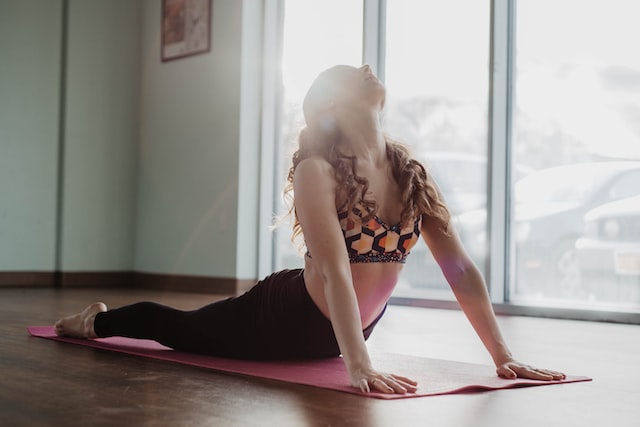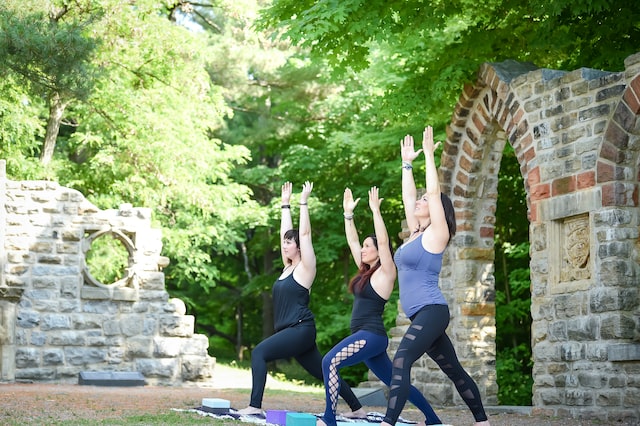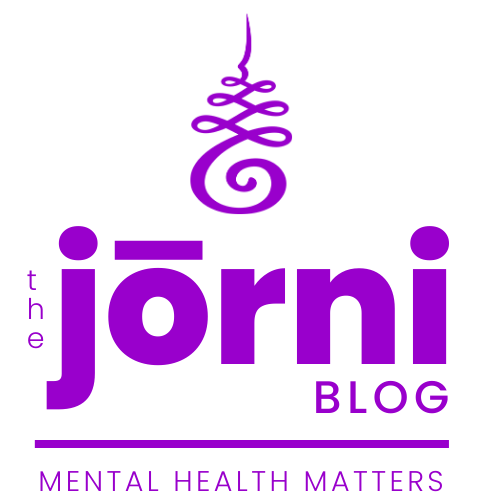Yoga for Wellbeing
Amongst many other things, yoga has been found to lower stress hormone levels within the body while increasing happy brain chemicals such as endorphins. Together with breathing techniques and meditation, yogic practice can help reduce anxiety and boost mood, all beneficial for improving overall physical and mental wellbeing.
On the podcast, my guest this week was Vicky Hardy. She is a yoga instructor and trauma survivor and brings her lived experience into her practice to support her students. Vicky began her journey many years ago after finding benefit with a physical injury.
She continued after surviving domestic abuse and ultimately decided to complete her yoga teacher training. Vicky has been teaching ever since and hasn't looked back.
Vicky teaches with a focus on functional mobility, as well as applying breath practice and mindfulness techniques to her practices. This approach supports accepting the body and its limitations for each student’s unique situation and helps with physical pain management and holistic healing.
“Yoga is the journey of the self, through the self, to the self.”
- The Bhagavad Gita
Yoga has been an amazing journey for myself as well. I first started after breaking my foot, to support my healing journey and my mental health. I found such profound healing and peace in yogic practice that I decided to complete my teacher training and incorporate the practice into the Guided Jōrni program. Especially in times of high stress and anxiety, it has been an invaluable addition to my daily life. In addition to improving body awareness, reducing stress, relaxing the brain, and focusing attention, regular practice also cultivates wellbeing and peace.
What is yoga?
Yoga is an ancient practice and originated in India over 5,000 years ago. Although little known in the west until a few decades ago, Western scientists and medical professionals are slowly acknowledging yoga as a powerful technique for fostering mental and physical wellbeing. There are different types and each works with the mind and body in different ways.
Yogic practice is so much more than just “poses” that most people associate with the modern classes and exercises today. The word “yoga” means to unite, which refers to the union of the mind and body. It is an ancient, holistic way of life. It incorporates daily routines, food, cleansing, postures, breathing, and meditation, while emphasizing the connection between the mind and body.

Yoga is frequently perceived as a fitness and wellness therapy or an exercise program. Although the benefits for physical and mental health are profound, the main goal is far broader. Yogic practice aims to bring you into harmony and alignment with the universe. This topic is much more complex than explaining poses or breathing exercises, but in short, the ultimate achievement for a yogi is enlightenment. The state of Samadhi, which can be thought of as a state of complete unity with, and dissolution into the universe.
For many people who attend classes, this is not what they are looking for. And in truth, it is not something the majority of enthusiasts will ever achieve. It takes a lifetime of dedication, practice, and living the yogic lifestyle, and even then, enlightenment is not guaranteed. So, for the purposes of this post and the podcast episode, we can think of yoga as the more westernized version most people will be familiar with.
Yoga and Mental Wellbeing
As we already touched on, yogic practice can happen in a variety of forms. Hatha yoga is the variety most frequently practiced in the United States; it combines physical positions, or poses, and deliberate breathing. A regular yogic practice can increase strength, range of motion, flexibility, and balance. Although the benefits of improved mental wellbeing may be more difficult to quantify, it has been proven to support mental wellbeing. Most exercises cause the brain's "feel-good" chemicals to be released. Despite being calm and regulated, yogic motions still increase heart rate, utilize various muscles, and encourage the release of these brain chemicals.
Researchers have started to compare consistent yogic practice with other therapies, including medication and psychotherapy. Yoga typically costs less money and has fewer adverse effects than many medications. Even people diagnosed with depressive disorder have been shown to benefit from a yogic practice. More research is needed to explore yoga's potential to help with depression, but these initial findings are positive.

In a survey asking Americans why they practiced yoga, 86% responded it helped them manage stress. Tension can be decreased through specific muscle movements and breathing techniques that yoga provides. This also includes anxiety. Emphasis on breath control can be beneficial in managing anxiety and yoga therapy has been recommended by some psychologists for helping with stress and anxiety.
Yogic practice can also help with better sleep, which can be an underlying factor for mental distress and chronic illnesses. This might be of interest in particular to older practitioners. Participants in a study who were over 60 years old reported better and longer sleep. In addition, yoga may help with managing chronic illnesses. Of course, outcomes will vary, but it has the potential to profoundly impact overall health and wellbeing.
Working with a Trauma-Informed Yoga Teacher
Depending on your personal situation, you may find the thought of a consistent yogic practice daunting. Maybe you do not feel comfortable in the presence of a group. Or maybe you do not like touch or physical contact. And possibly the thought of feeling your own body and emotions can be overwhelming. If you are a trauma survivor, have neurodivergent traits, or have mobility challenges, it may be beneficial to work with a trauma-informed teacher like Vicky.

Vicky discussed various advantages of practicing with a trauma-informed instructor. Trauma-informed teachers give you the tools you need to focus your attention inside in a way that feels safe. This could include experimenting with different forms of a pose or moving on to something different. She can also help with regulating physical reactions, which in turn helps manage emotions. Vicky can help reestablish a sense of safety inside the body, by helping students recognize and work with physical feelings.
Trauma-informed teachers can also provide a range of experiences to foster recovery and healing. The inclusive language that encourages decision-making promotes a secure and encouraging environment. Giving students a choice as to poses and corrective touch fosters safety. And if you are triggered in a session, your teacher can help you regulate, re-align, or provide you with a safe space to exit to.
The Takeaway
Yoga can be a great option for a variety of things that may be happening in your life. If you are recovering from a physical injury, you may benefit from gentle yoga that focuses on healing and restoring. If you are experiencing mental distress or chronic pain, yogic practice can be beneficial for supporting wellbeing and managing chronic pain.
Yoga is offered in many varieties, so be sure you choose the type that is appropriate for you. If you have an injury or mobility challenges, start with something gentle and supportive like Yin Yoga. When you are ready for a more vigorous form of yoga, consider something more along the lines of Ashtanga Yoga. Be sure to listen to your body at all times and respect the boundaries you may experience with movement and stamina.

Yoga is also a form of mind-body medicine and can work very well for trauma recovery. It has a lot to teach us about comprehending the human mind and all facets of our complex existence. Choose a trauma-informed teacher, for working on trauma release and recovery. If you would like to dive deeper into physical and mental wellbeing, you can engage in a yogic lifestyle, which can bring profound healing and change.
I cannot stress enough how important it is to work with a certified and experienced teacher.
This is to ensure you do not injure yourself and have someone to guide and support you at all times. Because many people think yogic practice is just a bunch of poses, you may not entirely understand the profound impact it can have and a teacher can guide you in your journey.
Experience the healing potential of yoga for yourself and find out if it is something to add to your healing journey!
Diggory, T. (2021, September 1). 5 ways to achieve happiness through yoga. Calmer. Retrieved September 24, 2022, from https://www.thisiscalmer.com/blog/5-ways-to-achieve-happiness-through-yoga
Effects of yoga on functional capacity and well being. (n.d.). NCBI. Retrieved September 24, 2022, from https://www.ncbi.nlm.nih.gov/pmc/articles/PMC3573548/
Increased well-being: Another reason to try yoga. (n.d.). Harvard Health. Retrieved September 24, 2022, from https://www.health.harvard.edu/mind-and-mood/increased-well-being-another-reason-to-try-yoga
Lynton, R. (2020, June 4). Yoga, Mental Health & Wellbeing. Psychological Health Care. Retrieved September 24, 2022, from https://www.psychologicalhealthcare.com.au/blog/yoga-for-mental-health/
Yoga for Wellbeing | SkillsYouNeed. (n.d.). Skills You Need. Retrieved September 24, 2022, from https://www.skillsyouneed.com/ps/yoga-for-wellbeing.html
https://thejornipodcast.com/episode-32-yoga-and-wellbeing-with-vicky-hardy
